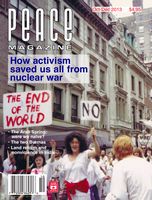
Peace Magazine Oct-Dec 2013, page 27. Some rights reserved.
Search for other articles by Jan Slakov here
I remember seeing a Remembrance Day display in an elementary school with battle images and the question: “Would you die for your country?”
Lots to reflect on there! Of course the other question was left off: “Would you kill for your country?” The assumption behind the display, and in much of the official Remembrance Day discourse, is that we owe our freedoms to people dying (and killing) on our behalf.
I am acutely aware of how powerful elite forces enlist people’s support for wars through twisted truths, outright lies, and manufactured crises. And I dedicate much of my energy to the conviction that creating a culture of peace is possible and that conflicts can be dealt with in ways that foster understanding and the rule of law and that prevent violence.
So I was always quite uneasy with how Remembrance Day is generally commemorated. When I first read about the white poppy tradition, in an article by Greenham Common veteran Kris Mansfield, I was thrilled. Here was a way to remember, not just “our” soldiers but all victims of war. For me, the white poppy is also a symbol of remembrance for those who fight for freedom and justice nonviolently.
I could never discount the convictions of those for whom the red poppy holds great value and I know the values I hold most dear are shared and upheld by many people in uniform, so I wear a red poppy too. Author Heather Menzies found out that the John McCrae poem which gave rise to the red poppy tradition, was actually conceived of as a cry to resist militarism. In a 1984 editorial,Globe and Mail editor Richard J. Doyle stated: “The words that are not often recalled when McCrae is remembered are his comment to a Canadian chaplain that the ‘foe’ mentioned in the line ‘take up our quarrel with the foe’ was not intended to be the German or Austrian soldier; it was the spirit of warfare.”
Some hesitate to wear a white poppy because of the controversy surrounding it, which reached a peak in 2006 when the Canadian Legion threatened legal action against an Edmonton store which was selling white poppies. Since then, people involved in the white poppy campaign have met with top Legion officials. And groups such as VOW (Canadian Voice of Women for Peace), Conscience Canada and Ottawa Poppy Coalition are committed to refrain from using the white poppy as a fundraising tool; the Legion’s support for veterans, especially when our government is failing to provide adequate support, is important to us.
In recent years the Quebec’s Échec à la guerre group has sponsored an effective white poppy campaign, distributing thousands of locally-made poppies.
Indeed, it is likely that the white poppy tradition is helping to keep Remembrance Day meaningful. It enables people who might otherwise object to official remembrance events, especially under the current Harper government, to participate. And it challenges all of us to think about how we can work for peace and justice in the way we live our everyday lives.
To learn more, check out the websites of any of the above-mentioned groups or the Peace Pledge Union in Britain or Google “peace poppies.” For sample poppies or for ideas on how to make your own, contact janslakov@shaw.ca or (250) 537-5251.
Jan Slakov is involved in several peace groups, including Voice of Women, Conscience Canada and WILPF. She lives on Salt Spring Island, BC.

Peace Magazine Oct-Dec 2013, page 27. Some rights reserved.
Search for other articles by Jan Slakov here